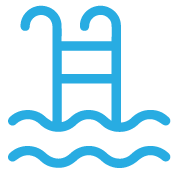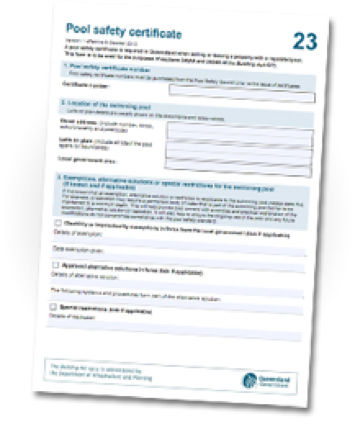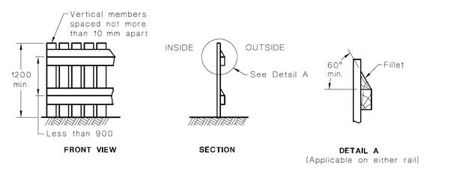Pool Safety Inspections.
In December 2010 the Queensland Government introduced Pool Owners Legislation that makes it compulsory for all home owners with a pool and or spa to have it inspected prior to selling or leasing their home. AAA Cairns Pool Safety Inspections are the leaders in pool safety. We service Cairns & surrounding areas.
Is Your Pool Fence Legal?
As a pool owner or potential pool owner, you must maintain your pool fence to the safety standards.
AAA Cairns Pool Safety Inspections will inspect your pool and either issue you with a Pool Safety Certificate (Form 23) or if issues exist with the pool fence a Non-Compliance Notice (Form 26). If your pool passes the first inspection a pool safety certification will be issued within 48 hrs.
If you have any Non-Compliant Issues a report will be written giving detail of the Issues along with photos showing the Issues and various ways of repairing, replacing, adjusting or changing the affected area to an acceptable standard. This report will be sent via email to you. The repairs then need to be done within 90 days after the initial inspection.
When to get a Pool Safety Certificate?
A Pool Safety Certificate is the form required to prove that your pool/spa fence is compliant with the latest Queensland pool safety standards. This is a requirement only when properties are sold or leased. If you manage a shared pool or provide accommodation, it is mandatory to renew your pool safety certificate every year. All other pool/spa fences on properties need to be kept to the same Queensland pool safety standards, a certificate is not always required. If you are unsure if your pool/spa fence meets the required standards AAA Cairns Pool Safety Inspections can still come and inspect your pool/spa fence and give you all the advice required to ensure it meets that standard.
Buying or Selling a property with a Pool or Spa.
If you’re selling a property with a Pool or Spa it’s in your best interest to arrange an inspection. You can get any non-compliant issues sorted out and obtain a pool safety certificate prior to the sale of your property.
If you’re buying a property with a Pool or Spa and the Seller does not have a current pool safety certificate, it’s even more important that the pool fence is inspected to make sure there are no nasty surprises waiting for you after settlement.
Basic Pool Fence Requirements.
Pool fences are an important safety element to reduce the number of injuries and fatalities to children. Your pool fence needs to be in a condition where it restricts entry to the pool area by being in good physical condition and not having any elements which could be used as foot holds or climbing aids. Timber fences should be checked for loose palings and posts. If the fence is not in good condition or is showing signs of movement, it should be replaced. If palings are loose, all palings should be refixed. Metal fences should be checked for signs of corrosion, movement, and low strength. If horizontal bars are weak and can be pulled apart, the fence or connections are loose, or there are signs of corrosion the fence will need to be fixed or replaced.
The Standard requires the following criteria be met:
Pool fences must be –
• 1200mm high with no climbing aids in the vicinity of the fence
• 1200mm from the top of any nearby steps to top of fence at any point (for example where the fence steps down, measure diagonally from top of step to top of fence on step).
• Horizontal rails must be spaced at a minimum spacing of 900mm, unless top surface of rails is greater than 60 degrees or gaps in fence are no more than 10mm see figure 3.
• Vertical rails must be no more than 100mm apart and of adequate strength, so that a child could not pull them more then 100mm apart.
• The gap between the bottom of the fence and the ground be no more than 100mm
• The ground beneath the fence must be firm enough so that it cannot be easily removed by a child.
• Have no climbable objects within a 900mm radius of the top of the fence.
• Have no climbable objects within 300mm of the inside of the fence, if the pool fence is not solid, see figure below
• Have no climbable objects within a 1200mm radius of the top of the fence, within 900mm out from the front of the fence, see figure Below.
Pool Fence Gate Requirements.
Pool fence gates must meet the following requirements:
Pool fence gates –
• Must be in good condition
• Must offer no foot holds or climbing aids
• Must be self-closing and self-latching from any open position, even when shut from a ‘slightly ajar’ position
• Must open outwards (away from the pool)
• Must be fitted with a self-closing latch.
• Hinges must have a minimum spacing of 900mm, measured from the top of the bottom hinge to the top of the top hinge. Alternatively a 60 degree angle cap can be placed on the top side of the hinges but the gap between, the gate and the fence or the gate and the post, must be less then 10mm.
• Must meet the same requirements as a pool fence as listed above.
Figure 3 (Australian Standards 1926.1 2007)
Pool Fence Latch.
A Latch must be fitted to every pool fence gate and must meet the following requirements.
• If Latch is fitted to the outside of the pool fence it must be 1500mm above ground level, and 1400mm above any horizontal rails within the bottom 900mm of the pool fence. Ignore horizontal rails with a top surface of 60 degrees or greater, see figure 3.
• If latch is fitted inside the pool fence it must be 300mm below the top of the fence. Shielding will be required to stop children reaching through the fence to open the latch.
Signs.
Every pool must contain a ‘Resuscitation instruction’ or CPR chart displayed in a visible area within the enclosure.
Doors.
No doors may open into the pool enclosure. If you have doors opening into your pool enclosure these must be permanently fixed shut to meet the requirements of Standard AS1926.1 (Pool fencing).
Windows.
Windows may open into the pool enclosure to a maximum gap of 100mm. If you wish to have windows opening more than 100mm, a fixed security screen must be installed on the window to disable access to the pool enclosure. Louvers with a spacing greater then 100mm when open would not pass a pool safety inspection. Windows with a sill height of 900mm above floor level and fitted with a tight fitting fly mesh screen also comply with the pool fencing standard.
Objects.
It is the pool owner’s responsibility to ensure no objects which may act as climbing aids are placed by the pool fence. This includes pots, chairs, tables, barbeques, pool pumps, ect.
The above overview is provided as a guide only. There may be errors, or it may be out dated. This lists only the most basic requirements and your fence may need to meet additional requirements that are not listed here.
Pool safety compliance video.
This video takes a close look at what you need to know in relation to Queensland’s pool safety standards. These tips are just a guide.
Any questions contact us.
Pool Compliance Checklist.

Click Here (opens in new window)
Our Checklist

This checklist will help you check the basic requirements of a safe swimming pool area. If issues with your fence and gate can be addressed prior to the initial Inspection you could save yourself the cost of a second inspection.
Click Here (Download PDF list.)
Pool Registered.

A quick check on the Govt. database to make sure your pool is registered.
Check Here (opens in new window)




